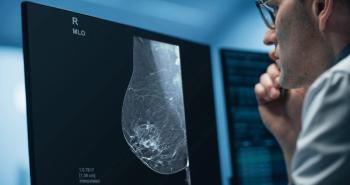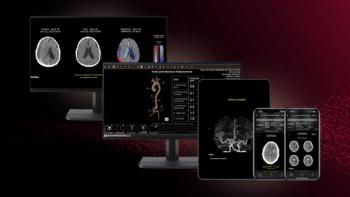
Physicists design hybrid of MR and radiotherapy
A new generation of radiation therapy machines may have built-in MRI systems to guide them, according to research presented at the annual American Association of Physicists in Medicine meeting in late July in Seattle.
A new generation of radiation therapy machines may have built-in MRI systems to guide them, according to research presented at the annual American Association of Physicists in Medicine meeting in late July in Seattle.
Jan Lagendijk of the University Medical Center Utrecht described plans for a hybrid MR/radiotherapy machine whose images of tumors could direct the delivery of radiotherapy. With collaborators at UMC Utrecht, Elekta Oncology Systems (U.K.), and Philips Research, Hamburg, Lagendijk is leading the development of a small, single-energy (6-megavolt) accelerator mounted in a ring surrounding a modified 1.5T MR system. The high-energy radiation source is being designed to rotate around the patient.
Feasibility tests have focused so far on Monte Carolo simulations and the placement of MR systems in radiation fields.
"It will take at least four or five years before we have a real prototype that we can use," Lagendijk said.
The need for soft-tissue targeting is well established. Tumors change from day to day, especially when treatment induces regression, which makes it difficult to know where to direct radiation. Radiation fields known to be larger than the tumor are often used to ensure the entire tumor is irradiated, but this means that patients receive suboptimal doses.
Several different types of imaging are being developed to assist with tumor position verification, including x-ray, ultrasound, and CT. All are limited, however, in how well they can define soft tissue such as tumors.
MRI has the advantage of quickly creating images of soft tissues, and it can display them in any orientation. This makes the modality ideal for tumor imaging, Lagendijk said.
Among the challenges is coupling the MR system and the accelerator. The MR field disturbs the operation of the accelerator. Conversely, magnetization of the accelerator components modifies the 1.5T magnetic field, leading to image distortion.
Lagendijk and his colleagues found that the active magnetic shielding built into standard MRI systems can be modified to minimize the magnetic field near crucial components of the accelerator. This adverse effect can be completely nullified at the accelerator gun section.
The best model, according to the researchers, builds the irradiator outside a cylindrical closed-bore magnet, which means that the irradiating beam will travel through the MRI system. They have designed special gradient coil sets with windows that allow many different patterns of radiation to travel through the coil while minimizing scatter of the accelerator radiation.
Modifying the MR system in this way should create no significant compromise in imaging performance, Lagendijk said.
Using this setup, the photon beam from the accelerator would travel unabated, but the trail of energy-depositing electrons would be distorted by the magnetic field, Lagendijk said. This distortion will send electrons at tissue-air boundaries on curved paths, so that they reenter the body immediately after exiting. The result will be sharply increased radiation dosages at the skin and at air-filled cavities inside the body.
Lagendijk expects to compensate for this effect by shooting radiation beams at each other from opposites sides of the machine. Doing so might actually turn the effect to advantage, under some circumstances. If the tumor is next to an air-filled cavity, this electron behavior could be exploited to direct a concentrated dose of radiation to the tumor.
The Utrecht researchers are fine-tuning the measurement of absolute radiotherapy dosages and trying to come up with the best coil design for the MR system. They are also considering potential problems with radiofrequency interference. But they have yet to come across any "significant technical problems," Lagendijk said.
Newsletter
Stay at the forefront of radiology with the Diagnostic Imaging newsletter, delivering the latest news, clinical insights, and imaging advancements for today’s radiologists.




























